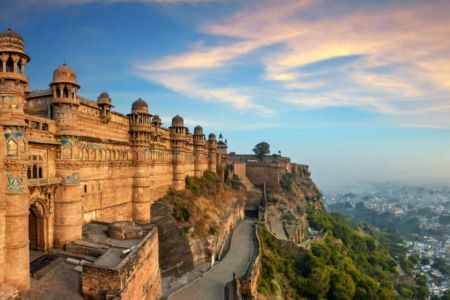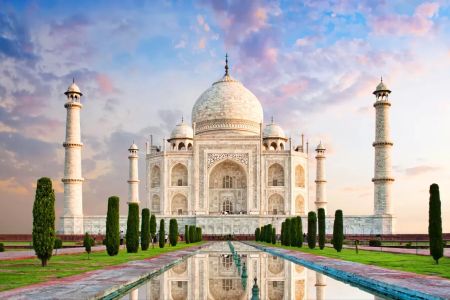Exploring the Best Historical Sites to Visit in India
India, with its rich and diverse history, is home to some of the most fascinating historical sites in the world. From ancient temples to grand palaces, India offers a treasure trove of landmarks that tell the stories of empires, kings, and cultural transformations. Whether you're a history enthusiast or simply a curious traveler, these historical sites in India are a must-visit.
1. Agra Fort
Agra Fort, located in the city of Agra, is a UNESCO World Heritage Site and one of the most significant historical landmarks in India. Built by Emperor Akbar in the 16th century, the fort is an impressive example of Mughal architecture. The red sandstone structure houses several important buildings, including the Jahangir Palace and the Diwan-i-Am (Hall of Public Audiences). The fort played a key role in the history of the Mughal Empire and offers a glimpse into the grandiose lifestyle of the emperors.
Visitors can enjoy walking through the majestic gates, exploring the royal chambers, and viewing stunning views of the Taj Mahal from the fort's vantage points. Agra Fort is an excellent example of India’s rich Mughal heritage, and its proximity to the Taj Mahal makes it an essential stop on any tour of the region.
2. Qutub Minar
Located in Delhi, the Qutub Minar is one of the tallest brick minarets in the world, standing at 73 meters tall. Built in the early 13th century, it is a remarkable example of Indo-Islamic Afghan architecture. The Qutub Minar is famous for its intricate carvings and inscriptions in Arabic, showcasing the blending of Persian and Indian styles of architecture. Visitors can marvel at the detail of the carvings and enjoy the historical significance of the site.
What makes the Qutub Minar even more captivating is the surrounding Qutub Complex, which includes several other historical sites, such as the Quwwat-ul-Islam Mosque. The site offers visitors a glimpse into the Islamic architectural influence on India during the medieval period.
3. Red Fort (Lal Qila)
The Red Fort, or Lal Qila, located in Delhi, is one of the most iconic symbols of India's history. Built by Emperor Shah Jahan in the mid-17th century, the fort is a stunning example of Mughal architecture and a UNESCO World Heritage Site. It was the main residence of the Mughal emperors for around 200 years, until the British colonial period.
The fort is renowned for its large walls, beautiful gardens, and impressive structures, including the Diwan-i-Am and the Diwan-i-Khas. The Red Fort also houses the famous Jama Masjid, one of the largest mosques in India. Today, the fort serves as a site of national importance and attracts millions of visitors each year. The light and sound show held every evening is a must-see, as it brings the history of India’s struggle for independence to life.
4. Taj Mahal
No visit to India is complete without witnessing the breathtaking beauty of the Taj Mahal. Located in Agra, the Taj Mahal is one of the most famous historical sites in the world and an architectural marvel of the Mughal era. Built by Emperor Shah Jahan in memory of his beloved wife Mumtaz Mahal, the Taj Mahal is a symbol of eternal love.
Constructed using white marble, the Taj Mahal is renowned for its symmetrical design, intricate carvings, and stunning gardens. The monument’s beauty is most striking at sunrise and sunset, when the soft light reflects off the marble surface. As one of the New Seven Wonders of the World, the Taj Mahal remains an essential part of any Indian tour and continues to captivate visitors from all over the world.
5. Jaipur Palaces: Amber Fort and City Palace
Jaipur, known as the "Pink City," is home to two of the most spectacular palaces in India: Amber Fort and City Palace. Both of these magnificent palaces offer insight into the royal history and the grandeur of Rajasthan’s Rajput rulers.
Amber Fort, built in the 16th century, is perched on a hilltop overlooking the city. Visitors can take an elephant ride up to the fort, exploring the ornate courtyards, intricate carvings, and beautiful gardens. The fort’s Sheesh Mahal (Mirror Palace) is particularly famous for its stunning mirror work, which reflects light and creates a dazzling visual effect.
The City Palace, located in the heart of Jaipur, is a blend of Rajasthani and Mughal architecture. The palace complex houses several museums, courtyards, and gardens. Visitors can explore the various rooms, including the Chandra Mahal, which is still the residence of the royal family.
6. Mahabalipuram
Mahabalipuram, a coastal town in Tamil Nadu, is known for its UNESCO-listed Shore Temples and rock-cut sculptures. Dating back to the 7th and 8th centuries, the site was once a thriving port during the Pallava dynasty. The town is famous for its intricate carvings, including depictions of Hindu mythology and scenes from daily life in ancient times.
The Shore Temples, overlooking the Bay of Bengal, are a spectacular sight, particularly during sunset. The town is also home to the Pancha Rathas, a set of five monolithic rock temples that are carved into the shape of chariots. Mahabalipuram offers a unique blend of history, art, and stunning natural beauty.
7. Ajanta and Ellora Caves
The Ajanta and Ellora Caves, located in Maharashtra, are two of India’s most important rock-cut cave complexes. The Ajanta Caves, dating back to the 2nd century BCE, are famous for their stunning Buddhist murals and sculptures. The Ellora Caves, on the other hand, feature Hindu, Buddhist, and Jain temples and are known for their incredible stone carvings, including the massive Kailasa Temple, which was carved out of a single piece of rock.
Both sites are UNESCO World Heritage Sites and offer visitors an extraordinary glimpse into India’s religious and cultural history. The detailed murals and intricate carvings are a testament to the artistic and architectural skills of ancient Indian craftsmen.
Why Visit Historical Sites in India?
India's historical sites provide more than just a window into the past; they offer a chance to connect with the country’s cultural heritage and vibrant traditions. From the magnificent Taj Mahal to the serene Ajanta and Ellora caves, these landmarks are not only visually stunning but also deeply meaningful. They offer insights into India’s rich history, religious diversity, and artistic excellence.
For those planning a visit to India, exploring these historical sites is an essential experience. Whether you’re interested in architecture, religion, or simply immersing yourself in the stories of ancient civilizations, India’s historical sites are sure to leave a lasting impression. Ready to explore these incredible places? Book your trip today with Travel India One and experience the timeless beauty of India’s heritage!











